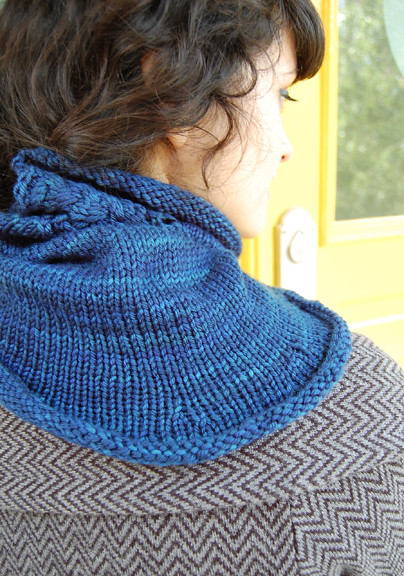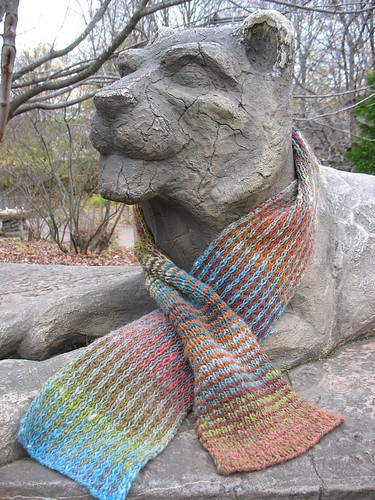I’ve been tagged for two memes–I’ll do Kristen’s first, because I’ve been thinking about it for a bit.
Both these memes are meant to be about me. I find it much more difficult to write about myself than to write about external things like books or knitting… perhaps because I find it stressful to be the center of attention, or perhaps for the same reason I’ve found it hard to answer when people say “what’s X person like?” or “what was it like to live in X place?” For complex subjects I know well, I don’t construct a simple narrative about them the same way I do for simple subjects or people/places I know only in passing. I should practice coming up with “elevator speeches” if I think I’ll be asked about something, but honestly, I never think about it until the question drops and I’m left stymied and stammering and going into far more detail than the person asking really wanted.
Anyway, here’s the six-word memoir I decided to write.
Searching for happiness. Is happiness enough?
Growing up, whenever I blew out the candles on my birthday cake, or blew dandelion fluff clean away, I always closed my eyes and simply wished to be happy. I didn’t ask for particular things to happen or for particular items. I wished for a state of mind. Mostly, as an adult, I’ve been successful in that. But–the essence of my quarterlife crisis–
Is happiness enough?
I went to Quaker church last Sunday with Rahul. The church is non-hierarchical, so you sit in silence in the meeting of Friends, and when someone feels moved to speak by the Holy Spirit, they stand up and say their piece. Best church I’ve ever been to, though being more spiritual than religious, I don’t know that I really believe in the Holy Spirit or a personified God. Anyway, someone stood up at church and talked about a successful lawyer who had been moved to drop his career and move down to Nicaragua to live in a shack.
“What would the world be like,” the speaker said, “if all Christians felt like it was their Christian duty to be poor?”
Now, I don’t think that has to mean moving to Nicaragua and living in a shack. Studies have shown that money does buy happiness, up to a certain point, once your basic needs are met and you don’t feel afraid about where your next meal will come from. But what if we actively aspired to stop wanting at that point? Not passively, with the “camel through the eye of a needle” proverb in the back of the mind, or with alms or tithing as a sort of duty separate from ourselves, but actively, as a pillar of faith. What if we tried, like Buddhists (and not the kind of consumerist Buddhism that comes from buying prayer flags and wearing yoga pants) to let our desires fall away and ignore the I want mindset? If we stopped asking for more money, promotions, power, stopped buying stuff except when we needed it? What if we focused on love and simplicity and the things that please us?
What if we didn’t need more? Could it be enough to be happy?
I think we tend to give lip service to this idea, but in practice, without thinking about it, we value money, objects, status, and achievement more. We secretly look down on people who reach a certain point in their careers, not too high up the ladder, and then stop advancing, calling these “dead-end careers.” But is it always better to be at the top? You get more money and more status, but (depending on your particular position) you may trade off free time and your level of stress may skyrocket. There was some movie about this a few years back, where a very happy temp worker got hired full-time and his life went to hell.
I don’t mean to advocate selfishness, of course, or hedonism to the detriment of the greater good, and I’m all in favor of making enough money to take care of yourself both now and in the future. And it makes life so much easier to have lots of money, no question. But there’s a feeling in personal lives analogous to our ideas about the economy that more is better, growth is necessary, but what if it’s not only unnecessary but harmful? I read this interesting story in the Atlantic Monthly called Fear of fallowing: the specter of a no-growth world (abstract here) that goes into these ideas a bit, on an economic/societal scale rather than a strictly personal one–Collapse , by Jared Diamond, does as well, but then Diamond is a successful author and professor and doesn’t really need to worry about his place in the world.
, by Jared Diamond, does as well, but then Diamond is a successful author and professor and doesn’t really need to worry about his place in the world.
So, without going too far into the details, and without addressing consumerism (I have a wee problem with loving and acquiring stuff, though I’ve gotten much better about it in recent years) my current crisis is that despite sometimes feeling like I’ve never been happier, I get this vague itchy feeling like I ought to be doing more, achieving more, or making more money. But what if I already have enough? What if I could, but I don’t want to, and what if that’s enough? (Maybe I should move to Bhutan, where they measure and deeply value their Gross National Happiness.)
I’m feeling this crisis particularly right now because, well, I just filed my taxes and am feeling extremely poor and angry and grudgingly, selfishly in favor of this idiotic economic stimulus plan, because it will mean another $600 in my pocket. But on the other hand, I don’t really need it, I just hate having to pay the government a big chunk of money, and I know I could be making more. I can pay my rent and my bills and sock away money every month for retirement. And I have lots of free time and mental balance right now. But I can’t help thinking, sort of longingly, of the days when I had a lot more money and a lot less free time and general happiness.
I mean, springtime is finally here in Bloomington, and just look at it! Magnolias, sunshine, rainbow scarves, forsythia… would I really rather be stuck in a cubicle or in meetings in an office park until 10 PM, making a bit more money? (Um… maybe? Check back in with me in a year…)
Observe:
A star magnolia outside the public library:


Pink trees on 3rd Street:

A reversible scarf pattern I’ve been working on, called “The Water is Wide”–it will have 3 variations, and I’m working on the 3rd right now. Here are variations 1 and 2.
The main version shows wave cables on one side and a quilted “gull stitch” ribbing on the other side. It’s knit in Malabrigo Silky Merino in Indiecita, 2 skeins. I have lots of nice pictures of this that I took this weekend around the IU campus. I’ll share more later, but here are some of the outtakes I don’t plan to use in the final pattern:
Too nipply:


Shows construction in the background:

And here are some photos of version 2, a version showing quilted rib on both sides, knit with 2 skeins of Noro Kureyon and 1 skein of Plymouth Boku, all striped together. I might use some of these photos for the final pattern–I’m pleased with how they came out, but then I have a real weakness for rainbow-striped scarves, so how could I have gone wrong?
In the star magnolia:

Floating in forsythia:

TP

Close up

Far off

(Version 3 will show wave cables on both sides, but I ran out of yarn and have to wait for more to come in the mail. I hope the dyelots are similar. I love it so far–it’s luscious–but it eats yarn like crazy.)
This NPR story inspired the meme, and here are the guidelines:
Here are the guidelines, should you choose to participate in this yourself:
- Write your own six word memoir.
- Post it on your blog and include a visual illustration if you’d like.
- Link to the person that tagged you in your post and to this original post if possible so we can track it as it travels across the blogosphere.
- Tag five more blogs with links.
I hereby tag:
- Goldtop, in
revenge exchange for tagging me with the “seven things” meme
- gleek
- Emilee
- Kate
- Big Sister
(Apologies if you’ve been tagged before… I didn’t do a search to check. And no obligations here. It was definitely hard to figure out what to write in my 6-word bio, so totally I’ll understand if you don’t want to.)
And anyone else who wants to be tagged, please do participate and let me know!



















































